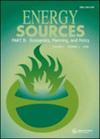A hybridized approach for design and optimization of combined economic emission dispatch
IF 2.2
4区 工程技术
Q3 ENERGY & FUELS
Energy Sources Part B-Economics Planning and Policy
Pub Date : 2021-09-20
DOI:10.1080/15567249.2021.1971800
引用次数: 2
Abstract
ABSTRACT This paper proposes a new algorithm, known as Refraction based Whale Optimization Algorithm (RWOA), for providing optimal solutions to the Combined Economic Emission Dispatch problem based on the production of an optimum solar energy system. It validates the robustness of the proposed algorithm in Hybrid Renewable Energy Systems (HRES). To control the emission and economic cost, it is necessary to connect the wind turbine with the thermal power plant. Finally, the performance of the proposed approach is compared with the other conventional approaches concerning the economic cost, emission cost transmission loss. Accordingly, the results, shows that the proposed RWOA method is 92.81%, 99.2%, 92.8%, 80%, 37.8%, 47.34%, and 45.83% superior to GA, GWO, WOA, DA, GWSO, LGSO and WWO at 40th iteration.综合经济排放调度设计与优化的混合方法
摘要针对基于最优太阳能系统产量的联合经济排放调度问题,提出了一种基于折射的鲸鱼优化算法(RWOA)。在混合可再生能源系统(HRES)中验证了该算法的鲁棒性。为了控制排放和经济成本,有必要将风力发电机组与火电厂连接起来。最后,从经济成本、排放成本、传输损失等方面与其他传统方法进行了比较。结果表明,在第40次迭代时,RWOA方法比GA、GWO、WOA、DA、GWSO、LGSO和WWO分别高出92.81%、99.2%、92.8%、80%、37.8%、47.34%和45.83%。
本文章由计算机程序翻译,如有差异,请以英文原文为准。
求助全文
约1分钟内获得全文
求助全文
来源期刊

Energy Sources Part B-Economics Planning and Policy
ENERGY & FUELS-
CiteScore
6.80
自引率
12.80%
发文量
42
审稿时长
6-12 weeks
期刊介绍:
12 issues per year
Abstracted and/or indexed in: Applied Science & Technology Index; API Abstracts/Literature; Automatic Subject Index Citation; BIOSIS Previews; Cabell’s Directory of Publishing Opportunities in Economics and Finance; Chemical Abstracts; CSA Aquatic Science & Fisheries Abstracts; CSA Environmental Sciences & Pollution Management Database; CSA Pollution Abstracts; Current Contents/Engineering, Technology & Applied Sciences; Directory of Industry Data Sources; Economic Abstracts; Electrical and Electronics Abstracts; Energy Information Abstracts; Energy Research Abstracts; Engineering Index Monthly; Environmental Abstracts; Environmental Periodicals Bibliography (EPB); International Abstracts in Operations Research; Operations/Research/Management Science Abstracts; Petroleum Abstracts; Physikalische Berichte; and Science Citation Index.
Taylor & Francis make every effort to ensure the accuracy of all the information (the "Content") contained in our publications. However, Taylor & Francis, our agents, and our licensors make no representations or warranties whatsoever as to the accuracy, completeness, or suitability for any purpose of the Content. Any opinions and views expressed in this publication are the opinions and views of the authors, and are not the views of or endorsed by Taylor & Francis. The accuracy of the Content should not be relied upon and should be independently verified with primary sources of information. Taylor & Francis shall not be liable for any losses, actions, claims, proceedings, demands, costs, expenses, damages, and other liabilities whatsoever or howsoever caused arising directly or indirectly in connection with, in relation to, or arising out of the use of the Content. Terms & Conditions of access and use can be found at http://www.tandfonline.com/page/terms-and-conditions .
 求助内容:
求助内容: 应助结果提醒方式:
应助结果提醒方式:


